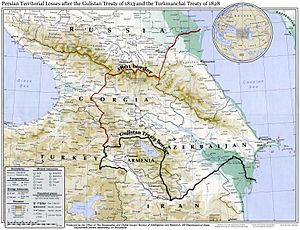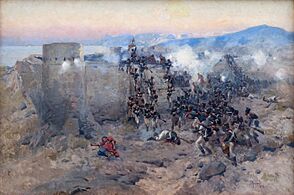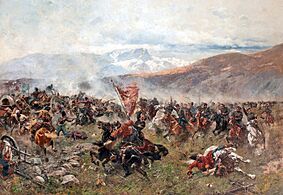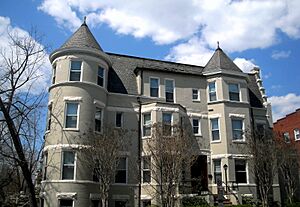Qajar Iran facts for kids
Quick facts for kids
Sublime State of Iran
|
|||||||||||||
|---|---|---|---|---|---|---|---|---|---|---|---|---|---|
| 1789–1925 | |||||||||||||
|
Anthem: (1873–1909)
Salâm-e Shâh (Royal salute) (1909–1925) Salamati-ye Dowlat-e 'Aliyye-ye Iran (Salute of the Sublime State of Iran) |
|||||||||||||
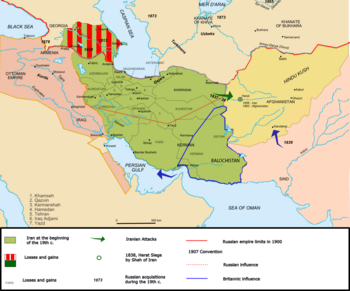
Map of Iran under the Qajar dynasty in the 19th century.
|
|||||||||||||
| Capital | Tehran | ||||||||||||
| Common languages |
|
||||||||||||
| Religion | Shia Islam (official) minority religions: Sunni Islam, Sufism, Judaism, Zoroastrianism, Christianity, Baháʼí Faith, Mandaeism |
||||||||||||
| Government |
|
||||||||||||
| Shah | |||||||||||||
|
• 1789–1797 (first)
|
Agha Mohammad Khan Qajar | ||||||||||||
|
• 1909–1925 (last)
|
Ahmad Shah Qajar | ||||||||||||
|
Grand viziers/Prime minister
|
|||||||||||||
|
• 1795-1801 (first)
|
Hajji Ebrahim Shirazi | ||||||||||||
|
• 1923–1925 (last)
|
Reza Pahlavi | ||||||||||||
| Legislature | None (until 1906; 1907–1909) National Consultative Assembly (1906–1907; from 1909) |
||||||||||||
| History | |||||||||||||
|
• Establishment
|
1789 | ||||||||||||
|
• Treaty of Gulistan
|
24 October 1813 | ||||||||||||
|
• Treaty of Turkmenchay
|
10 February 1828 | ||||||||||||
| 4 March 1857 | |||||||||||||
|
• Treaty of Akhal
|
21 September 1881 | ||||||||||||
| 5 August 1906 | |||||||||||||
|
• Battle of Robat Karim
|
December 27, 1915 | ||||||||||||
|
• Deposed by Constituent Assembly
|
31 October 1925 | ||||||||||||
| Currency | toman (1789–1825) qiran (1825–1925) |
||||||||||||
|
|||||||||||||
The Qajar Empire was a powerful Iranian state ruled by the Qajar dynasty from 1789 to 1925. This family came from a Turkic tribe called the Qajar tribe. They took full control of Iran in 1794. They also brought back Iranian rule over large parts of the Caucasus region. In 1796, Agha Mohammad Khan Qajar became the first Shah (king) of the Qajar dynasty.
During the 1800s, the Qajar Empire lost a lot of land in the Caucasus to the Russian Empire. This included areas that are now eastern Georgia, Dagestan, Azerbaijan, and Armenia. Even with these losses, Qajar Iran kept its independence. However, it faced big challenges from the Russian and British empires. Foreign advisors gained a lot of power in the government and military. In 1907, Britain and Russia even divided Iran into areas where they had special influence.
In the early 1900s, the Persian Constitutional Revolution led to the creation of an elected parliament called the Majles. This movement aimed to make Iran a constitutional monarchy, where the king's power was limited by a constitution. However, many of these changes were stopped by an intervention from the Russian Empire. Qajar Iran's borders became even weaker during World War I when the Ottoman Empire invaded. In 1925, a military officer named Reza Shah took power. He started the Pahlavi dynasty, which was the last royal family to rule Iran.
Contents
A Look at Qajar History
How the Qajars Began
The Qajar rulers were part of a larger group of Oghuz Turks. They first settled near Armenia during the Mongol period. They were also one of the seven tribes that supported the Safavid dynasty. The Safavids allowed local Turkic leaders to rule parts of what is now Azerbaijan.
Over time, many Qajars settled in Astarabad (now Gorgan, Iran). This branch of the Qajars eventually became very powerful. A key ancestor, Fath Ali Khan, was a famous military leader in the early 1700s. His grandson, Agha Mohammad Khan Qajar, would later become the first Qajar Shah.
Rising to Power
The Qajars came to power with the help of Turkic tribal fighters. They also used educated Persians to manage the government. After the death of Karim Khan of the Zand dynasty in 1779, Agha Mohammad Khan Qajar began to reunite Iran. He was known for being a very strict ruler. He took control of cities and regions, bringing them under his rule.
By 1794, Agha Mohammad Khan had defeated all his rivals. He brought the Caucasus region back under Iranian control. He made Tehran his capital city. In 1796, he was officially crowned as Shah. Agha Mohammad Khan was killed in 1797. His nephew, Fath-Ali Shah Qajar, became the next ruler.
Reclaiming Georgia and the Caucasus
In the 1700s, Erekle II (Heraclius II) ruled eastern Georgia. He had made a deal with the Russian Empire in 1783 for protection. However, Russia later pulled its troops out of Georgia.
Agha Mohammad Khan wanted to bring Georgia back under Iranian rule. He saw Georgia as a part of Iran, just like any other province. He demanded that Erekle II end his treaty with Russia and accept Iranian rule again. Erekle II refused.

In August 1795, Agha Mohammad Khan led his army into Georgia. His forces marched directly to Tbilisi, the capital. A big battle took place between the Iranian and Georgian armies. The Georgians were greatly outnumbered and were defeated. The Iranian army took control of Tbilisi and carried off many captives.
After this victory, Agha Mohammad Khan was formally crowned Shah in 1796. Russia then declared war on Iran but soon recalled its army. Agha Mohammad Shah was killed in 1797. Two years later, in 1799, the Russians marched into Tbilisi. By 1801, Russia had taken over the weakened Georgian kingdom. This led to future wars between Iran and Russia.
Wars with Russia and Losing Land
In 1801, Russia took over eastern Georgia. In 1804, Russia attacked the Iranian town of Ganja. This started the Russo-Persian War of 1804–1813. Under Fath Ali Shah, the Qajars fought against Russia. However, the Qajar army lost badly. In 1813, Iran was forced to sign the Treaty of Gulistan. This treaty made Iran give up most of its lands in the Caucasus. These included modern-day Georgia, Dagestan, and most of Azerbaijan.
About ten years later, Russia invaded Iran's Erivan Khanate. This led to another war, the Russo-Persian War of 1826–1828. This war was even worse for Qajar Iran. Russia temporarily took over Tabriz. In 1828, Iran had to sign the Treaty of Turkmenchay. This treaty gave Russia control over the entire South Caucasus and Dagestan. It also meant Iran lost what is now Armenia and the rest of Republic of Azerbaijan. The new border was set at the Aras River.
Because of these two treaties, Iran lost lands that had been part of its empire for centuries. These areas north of the Aras River became part of Russia for about 180 years. Many people from these areas, especially Muslims, moved to mainland Iran.
People Moving from the Caucasus
After losing these lands, many people moved. Large groups of Muslims, like the Ayrums and Qarapapaqs, moved to mainland Iran. Some Circassians, Shia Lezgins, and other Muslims also moved. This happened because they did not want to live under Christian Russian rule.
Many of these people later played a big role in Iranian history. They formed most of the Persian Cossack Brigade, a military unit led by Russian officers. This brigade became very important in the later years of the Qajar dynasty.
The 1828 Treaty of Turkmenchay also allowed Russia to encourage Armenians from Iran to settle in the newly conquered Russian lands. Before this, Muslims were the majority in Eastern Armenia. After the Russian takeover, Armenians started to become the majority in that area again.
Growth and Challenges
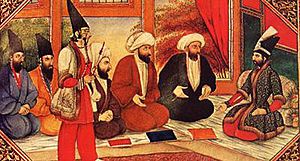
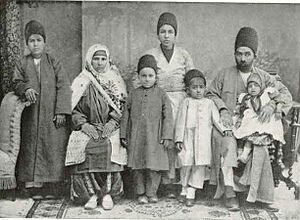
During Fath Ali Shah's rule, Iran started having more contact with Western countries. European powers began to compete for influence in Iran. His grandson, Mohammad Shah, became king in 1834. He was influenced by Russia and tried twice to capture Herat but failed.
When Mohammad Shah died in 1848, his son Naser al-Din became Shah. He was one of the most successful Qajar rulers. He brought Western science, technology, and education to Iran. He also started the country's modernization. Naser al-Din Shah tried to keep Iran independent by playing Britain and Russia against each other. However, foreign interference and loss of land still increased under his rule.
In 1856, during the Anglo-Persian War, Britain stopped Iran from taking back control of Herat. Britain also expanded its control in the Persian Gulf. By 1881, Russia had conquered parts of what are now Turkmenistan and Uzbekistan. This brought Russia's border right up to Iran's northeastern edge. Iran lost its historic ties to cities like Bukhara and Samarqand. The Treaty of Akhal in 1881 made Iran give up all claims to these areas.
Many Iranians felt that their rulers were too influenced by foreign countries.
Mirza Taghi Khan Amir Kabir was an important advisor to young Naser al-Din Shah. When Naser al-Din became Shah, Amir Kabir became the prime minister.
At this time, Iran was almost out of money. Amir Kabir started many important reforms. He cut government spending and separated the king's money from the country's money. He improved how the government worked. He also tried to limit foreign interference and encouraged trade. He even started building public works, like a bazaar in Tehran.
One of Amir Kabir's greatest achievements was building Dar ol Fonoon in 1851. This was the first modern university in Iran and the Middle East. It was built to train new government officials and teach them Western methods. Amir Kabir hired French, Russian, and Iranian teachers. They taught subjects like language, medicine, law, history, and engineering.
However, these reforms made some powerful people angry. They saw Amir Kabir as a threat. They formed a group against him, including the queen mother. She convinced the young Shah that Amir Kabir wanted to take his throne. In 1851, the Shah removed him from power and later had him killed.
Qajar Iran became a part of the "Great Game". This was a rivalry between Russia and Britain for power in Central Asia. Both empires tried to gain influence in Iran through military actions, diplomacy, and trade. Russia gained a lot of power in Iran after the 1828 Treaty of Turkmenchay. The Qajar kings often relied on loans from Britain and Russia.
In 1879, Russia helped create the Persian Cossack Brigade. This military unit was led by Russian officers. It gave Russia more influence over the Qajar army. By the 1890s, Russian teachers, doctors, and officers were very important at the Shah's court. They influenced government decisions. Both Russia and Britain invested in building roads and telegraph lines in Iran. However, their rivalry was so strong that they blocked each other from building railroads in Iran until 1907. In 1907, Britain and Russia officially divided Iran into areas of influence with the Anglo-Russian Convention.
The Constitutional Revolution
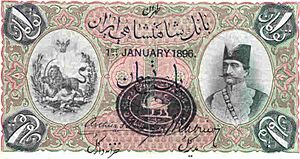
When Nasser al-Din Shah Qajar was killed in 1896, his son Mozaffar al-Din became king. He was a kind but not very effective ruler. The royal family spent a lot of money, and the government struggled financially. The Shah took large loans from Russia, partly for personal trips to Europe. People became angry as the Shah sold off rights, like road building and collecting taxes on imports, to European companies. This brought money to the Shah but gave foreigners more control. People wanted to limit the king's power and have a government based on law.
In 1906, many people, including merchants and religious leaders, protested. They demanded a "house of justice" or a consultative assembly. In August, the Shah promised a constitution. In October, an elected assembly called the Majles met. They wrote a constitution that limited the king's power and created a parliament with broad powers. The Shah signed the constitution on December 30, 1906, but he added a rule that he still had to sign all laws. He died five days later. The new laws allowed for freedom of the press, speech, and assembly. However, the hopes for a constitutional government were not fully realized.
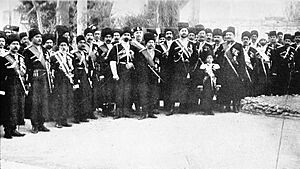
Mozaffar al-Din Shah's son, Mohammad Ali Shah (ruled 1907–1909), tried to cancel the constitution. With Russia's help, he used the Persian Cossack Brigade to attack the Majlis building in June 1908. He arrested many members and closed the assembly. However, people resisted in cities like Tabriz and Isfahan. In July 1909, constitutional forces marched to Tehran. They removed the Shah from power and brought back the constitution. The ex-Shah went to live in Russia.
On July 16, 1909, the Majles put Mohammad Ali Shah's 11-year-old son, Ahmad Shah, on the throne. Even though the constitutional forces won, they faced many problems. The country was unstable, and trade was difficult. The ex-Shah, with Russian support, tried to regain his throne.
The hope for independence from foreign powers ended when Britain and Russia agreed to divide Iran into areas of influence in 1907. Russia would control the north, Britain the south and east. They would compete in a neutral central area. In 1911, an American administrator named Morgan Shuster was hired to fix Iran's finances. He tried to collect taxes from powerful officials who were protected by Russia. Russia demanded his dismissal. When the Majlis refused, Russian troops moved to occupy the capital. To stop this, the Majles was forced to accept Russia's demands, and the assembly was closed again.
British and Russian officials worked together. The Russian army, still in Iran, invaded the capital again and suspended parliament. Many revolutionaries were executed. By June 1914, Russia controlled its northern zone, and Britain influenced the southeastern zone. Qajar Iran became a battleground for Russian, Ottoman, and British forces during World War I.
World War I and Its Impact
Even though Qajar Iran declared itself neutral in November 1914, the neighboring Ottoman Empire invaded shortly after. At that time, Russia had a lot of influence and troops in Iran. Because of this, Iran's neutrality was hard to enforce.
The Ottomans invaded Iranian Azerbaijan. Many battles took place there between the Russians and Ottomans. The Russians were helped by Assyrian and Armenian volunteer groups. When the Russian Revolution happened in 1917, most Russian troops left. This allowed the Ottomans to gain control of large parts of Iran until the war ended. During this time, Ottoman troops harmed many Assyrian and Armenian people in Iran.
Battle of Robat Karim
During World War I, Russian forces occupied northwest Iran. They marched towards Tehran, Iran's capital. This caused a crisis and led to the closing of the Iranian parliament. If Tehran had been captured, Iran might have become a permanent colony of Russia.
Ahmad Shah Qajar and his advisors thought about moving the capital to save the Qajar dynasty. But losing the capital could cause other cities to rebel.
The Battle of Robat Karim was a fight where Iranian people resisted the Russian army. They fought to protect Iran and keep it from being colonized. This battle gave Iranian politicians time to save the country. They decided to separate the royal capital (Tehran) from the government capital, which moved to Qom and then Isfahan. The royal capital stayed in Tehran.
Even though the Russians won the battle, the resistance at Robat Karim bought enough time. It prevented Iran from being fully taken over by Russia during World War I. Iran was saved from becoming a colony.
The End of the Dynasty
Ahmad Shah Qajar was born in 1898 and became king at age 11. However, Iran was occupied by Russian, British, and Ottoman troops during World War I. Ahmad Shah never fully recovered from this.
In February 1921, Reza Khan, the leader of the Persian Cossack Brigade, led a coup d'état. He became the real ruler of Iran. In 1923, Ahmad Shah went to live in Europe. In October 1925, Reza Khan convinced the Majles to remove Ahmad Shah and end the Qajar dynasty forever. Reza Khan then became the new monarch, known as Reza Shah Pahlavi. He ruled from 1925 to 1941.
Ahmad Shah died in France in 1930. Every future Shah of Iran would also die in exile.
Government and Military
At the start of Fath Ali Shah's rule, Iran was divided into five large provinces and many smaller ones. By 1906, there were 18 provinces. Most provincial governors in 1868 were Qajar princes.
The Qajar military was very important for the dynasty's power. However, foreign countries influenced it more and more over time. Tribal cavalry (horseback fighters) were a big part of the army until the late 1800s.
When Agha Mohammad Khan died in 1797, his army had 60,000 men. This included 50,000 tribal cavalry and 10,000 infantry (foot soldiers). The army of his nephew, Fath-Ali Shah, was much larger. By 1808, it had 180,000 men. This included 144,000 tribal cavalry and 40,000 infantry.
During the wars with Russia, Abbas Mirza commanded the army in the Azerbaijan Province. His forces were the main defense against the Russian invaders. His units were better organized than the rest of the Iranian army.
Russia created the Persian Cossack Brigade in 1879. This force was led by Russian officers and helped Russia gain influence in Iran.
By the 1910s, Qajar Iran was very decentralized. Foreign powers tried to strengthen the Qajar government by giving military aid. This was seen as a way to modernize the country, but it also led to more foreign control.
The Iranian Gendarmerie was founded in 1911 with help from Sweden. A neutral country like Sweden was chosen to avoid the "Great Game" rivalry between Russia and Britain. Iranian leaders hoped these reforms would make the country stronger against foreign influence.
After the Russian Revolution, many Russian officers from the Cossack Brigade stayed in Iran. Britain also formed the South Persia Rifles in 1916. In 1921, the Cossack Brigade, gendarmerie, and other forces were combined. They were supported by the British.
When the Qajar dynasty ended in 1925, Reza Shah's new Pahlavi army included members from the gendarmerie, Cossacks, and the South Persia Rifles.
Art and Culture
The Qajar period saw unique developments in Iranian art.
Population and People
In the late 1700s, during Agha Mohammad Khan's rule, Iran had about five to six million people.
By 1800, Iran's population was estimated at six million. A few years later, in 1812, it was about nine million. At that time, Iran had about 70,000 Jews, 170,000 Armenian Christians, and 20,000 Zoroastrians. Isfahan was the largest city with about 200,000 people.
Tehran became the capital in 1786. It was more like a military camp before becoming the capital. It had about 40,000 to 50,000 people when the royal court was there. In summer, the royal court and many residents moved to cooler areas. This would reduce Tehran's population to just a few thousand.
In eastern Iran, Mashhad had less than 20,000 people by 1800. Tabriz, a large city in the Azerbaijan Province, was once very rich. But an earthquake in 1780 damaged it. In 1809, Tabriz had about 50,000 people, including 200 Armenian families.
In 1868, Jews were the largest minority group in Tehran, with 1,578 people. By 1884, this number grew to 5,571.
Images for kids
-
Battle of Sultanabad, 13 February 1812. State Hermitage Museum.
-
Battle of Ganja, 1826. Franz Roubaud. Part of the collection of the Museum for History, Baku.
See also
- Qajar (tribe)
- Qajar dynasty
- Russo-Iranian War 1804–1813
- Russo-Iranian War 1826–1828
- Anglo-Iranian War 1856–1857
- Treaty of Gulistan
- Treaty of Turkmanchay
- Amir Kabir
- Dar ul-Funun
- Iranian Constitutional Revolution
- 1908 bombardment of the Majlis
- Occupation of Iran In World War I
- Iranian coup d'état 1921



